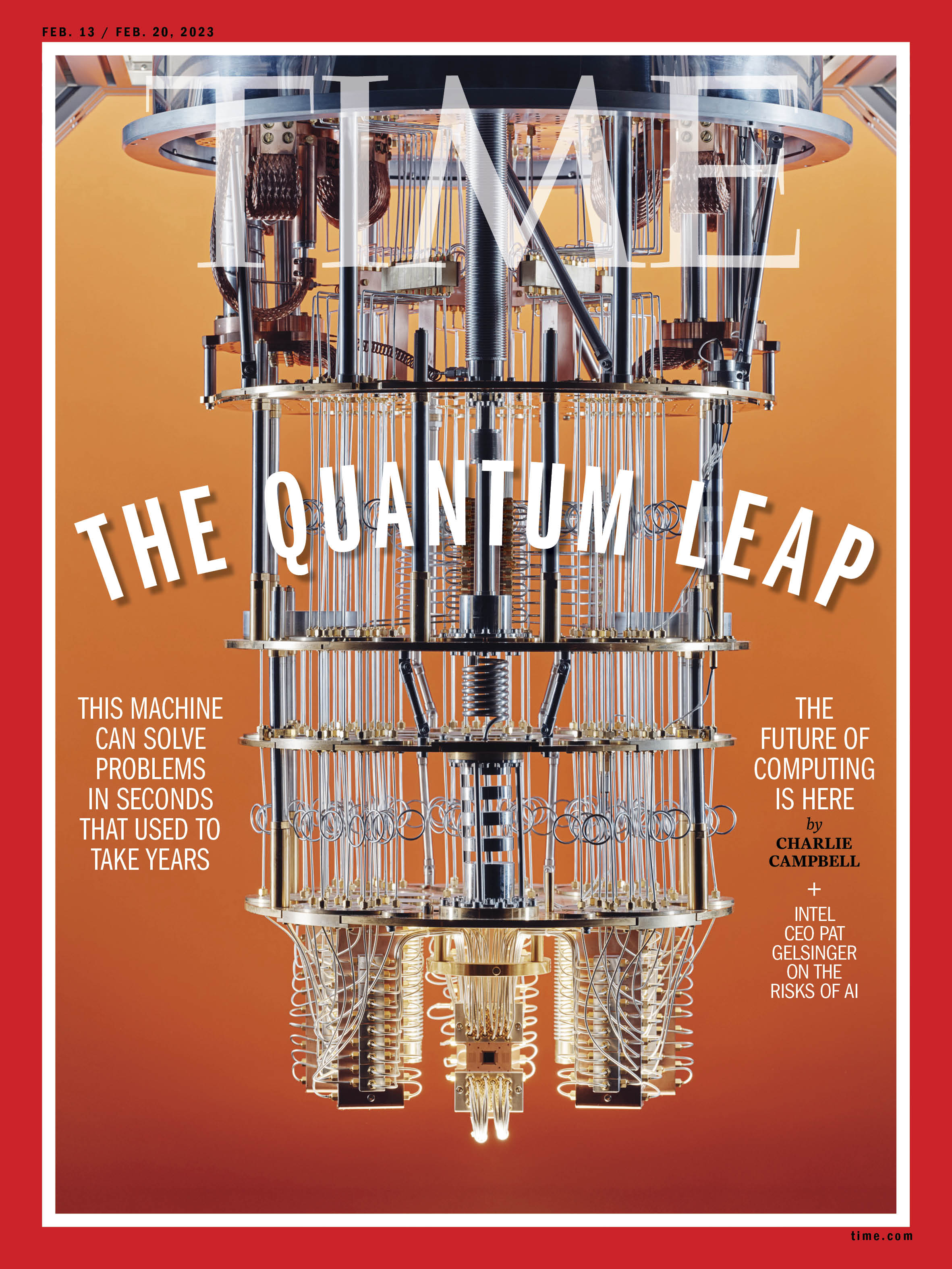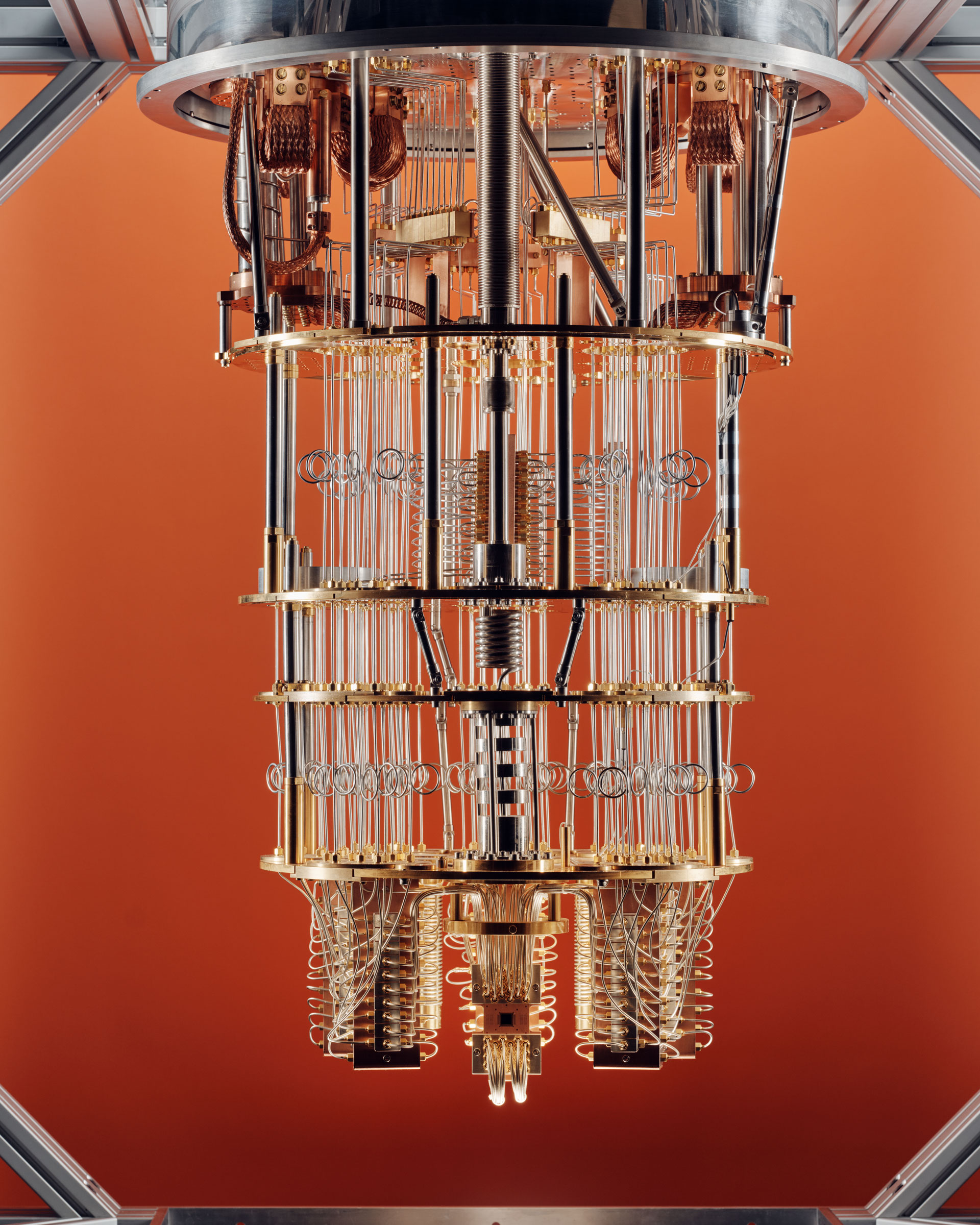One of the secrets to building the world’s most powerful computer is probably perched by your bathroom sink.
At IBM’s Thomas J. Watson Research Center in New York State’s Westchester County, scientists always keep a box of dental floss—Reach is the preferred brand—close by in case they need to tinker with their oil-drum-size quantum computers, the latest of which can complete certain tasks millions of times as fast as your laptop.
Inside the shimmering aluminum canister of IBM’s System One, which sits shielded by the same kind of protective glass as the Mona Lisa, are three cylinders of diminishing circumference, rather like a set of Russian dolls. Together, these encase a chandelier of looping silver wires that cascade through chunky gold plates to a quantum chip in the base. To work properly, this chip requires super-cooling to 0.015 kelvins—a smidgen above absolute zero and colder than outer space. Most materials contract or grow brittle and snap under such intense chill. But ordinary dental floss, it turns out, maintains its integrity remarkably well if you need to secure wayward wires.
“But only the unwaxed, unflavored kind,” says Jay Gambetta, IBM’s vice president of quantum. “Otherwise, released vapors mess everything up.”

Buy a print of the Quantum cover here
It’s a curiously homespun facet of a technology that is set to transform pretty much everything. Quantum’s unique ability to crunch stacks of data is already optimizing the routes of thousands of fuel tankers traversing the globe, helping decide which ICU patients require the most urgent care, and mimicking chemical processes at the atomic level to better design new materials. It also promises to supercharge artificial intelligence, with the power to better train algorithms that can finally turn driverless cars and drone taxis into a reality. Quantum AI simulations exhibit a “degree of effectiveness and efficiency that is mind-boggling,” U.S. National Cyber Director Chris Inglis tells TIME.
Read More: DeepMind’s CEO Helped Take AI Mainstream. Now He’s Urging Caution
Quantum’s earliest adopters are asset-management firms—for which incorporating quantum calculations involves few increased overhead costs—but commercial uses aren’t far behind. Spanish firm Multiverse Computing has run successful pilot projects with multinational clients like BASF and Bosch that show its quantum algorithms can double foreign-exchange trading profits and catch almost four times as many production-line defects. “Quantum deep-learning algorithms are completely different from classical ones,” says Multiverse CEO Enrique Lizaso Olmos. “You can train them faster, try more strategies, and they are much better at getting the correlations that matter from a lot of data.”


Tech giants from Google to Amazon and Alibaba—not to mention nation-states vying for technological supremacy—are racing to dominate this space. The global quantum-computing industry is projected to grow from $412 million in 2020 to $8.6 billion in 2027, according to an International Data Corp. analysis.
Whereas traditional computers rely on binary “bits”—switches either on or off, denoted as 1s and 0s—to process information, the “qubits” that underpin quantum computing are tiny subatomic particles that can exist in some percentage of both states simultaneously, rather like a coin spinning in midair. This leap from dual to multivariate processing exponentially boosts computing power. Complex problems that currently take the most powerful supercomputer several years could potentially be solved in seconds. Future quantum computers could open hitherto unfathomable frontiers in mathematics and science, helping to solve existential challenges like climate change and food security. A flurry of recent breakthroughs and government investment means we now sit on the cusp of a quantum revolution. “I believe we will do more in the next five years in quantum innovation than we did in the last 30,” says Gambetta.
But any disrupter comes with risks, and quantum has become a national-security migraine. Its problem-solving capacity will soon render all existing cryptography obsolete, jeopardizing communications, financial transactions, and even military defenses. “People describe quantum as a new space race,” says Dan O’Shea, operations manager for Inside Quantum Technology, an industry publication. In October, U.S. President Joe Biden toured IBM’s quantum data center in Poughkeepsie, N.Y., calling quantum “vital to our economy and equally important to our national security.” In this new era of great-power competition, China and the U.S. are particularly hell-bent on conquering the technology lest they lose vital ground. “This technology is going to be the next industrial revolution,” says Tony Uttley, president and COO for Quantinuum, a Colorado-based firm that offers commercial quantum applications. “It’s like the beginning of the internet, or the beginning of classical computing.”

If anything, it’s surprising that traditional computing has taken us so far. From the trail-blazing Apple II of the late 1970s to today’s smartphones and supercomputers, all processors break down tasks into binary. But life is so complex that rendering information in such a rudimentary manner is like playing a Rachmaninoff concerto in Morse code.
Quantum is also more in tune with nature. Molecules—the building blocks of the universe—are multiple atoms bound together by electrons that exist as part of each. The way these electrons essentially occupy two states at once is what quantum particles replicate, presenting applications for natural and material sciences by predicting how drugs interact with the human body, or substances perform under corrosion. Traditional manufacturing takes calculated guesses to make breakthroughs through trial and error; by mirroring the natural world, quantum should allow advances to be purposefully designed.
Read More: Column: How Our Cells Strategize To Keep Us Alive
While the world’s biggest companies, alongside hundreds of startups, are clamoring to harness quantum, IBM has emerged in recent years as the industry leader. Today, the firm has over 60 functioning quantum computers—more than the rest of the world combined—and a roster of collaborators that include titans of practically every industry from Exxon-Mobil to Sony. It’s a welcome return to technology’s zenith for the storied firm, founded over a century ago to produce tabulating machines fed with punch cards. In recent years, IBM had fallen behind rivals like Apple and Microsoft by not seizing the initiative with cloud computing and AI. Quantum offers some redemption. “It’s great to be back at the top again,” says one executive. “It’s no secret that we let things slip by not jumping on cloud.”
In November, IBM unveiled its new 433-qubit Osprey chip—the world’s most powerful quantum processor, the speed of which, if represented in traditional bits, would far exceed the total number of atoms in the known universe. IBM has more than 20 quantum computers available on its open-source quantum tool kit Qiskit, which has been downloaded more than 450,000 times to date. In order to build an industry around quantum, some machines are free to use, while paying clients such as startups and scholars can access more powerful ones remotely on a lease basis. IBM has a bold road map to launch a 1,121-qubit processor this year and, by 2025, surpass 4,000 qubits by creating modular quantum circuits that link multiple processor chips in the same computer. “Modularity is a big inflection point,” says Dario Gil, IBM senior vice president and director of research. “We now have a way to engineer machines that will have tens of thousands of qubits.”


Quantum’s industrial uses are boundless. Inside BMW’s headquarters in Munich there stands a wall that gives vehicle designers sleepless nights. Creating a new car model from scratch takes at least four years. First, designers use computer-aided styling to sketch an exterior that combines beauty with practicality. Next, a scale model is carved in clay and placed in a wind tunnel to assess aerodynamics. After countless decisions on interior, engine performance, and so on comes the ultimate test: a prototype is driven at 35 m.p.h. into that fabled wall to test how it performs in a crash. Should the car fail to meet various safety criteria, it’s back to the drawing board.
This is where quantum can help by accurately predicting how complex materials of different shapes will perform under stress. “Robust simulated crash tests can save up to six months in the whole process,” says Carsten Sapia, vice president of strategy, governance, and IT security at BMW Group, which has partnered with French quantum firm Pasqal. “Quantum computing will also help us find the new optimum between design, maximum interior space, and best aerodynamics.”
That’s just the start. Modern business teems with optimization problems that are ideally suited to quantum algorithms and could save time, energy, and resources. “We’re not just building the technology, we have to enable the workforce to use it,” explains Katie Pizzolato, IBM’s director of quantum strategy and applications research.
Sapia says finding uses for the technology is easy; the challenge will be ensuring that all divisions of BMW are able to utilize it. Already, BMW is unable to communicate from Europe to its cars in China for driving software maintenance and monitoring because of increasingly strict curbs on the transfer of data across borders. “In the future, we will rely on everywhere in the world having access to quantum technology to run our business,” Sapia says. “So how can we set it up so no matter what happens on a geopolitical scale that we still have access to this technology?”

Over the past few years quantum has moved from a footnote to the top of the global security agenda. To date, 17 countries have national quantum strategies and four more are developing them. China has invested an estimated $25 billion in quantum research since the mid-1980s, according to Quantum Computing Report. Its top quantum scientist, Pan Jianwei, led the launch of the world’s first quantum satellite in 2016 and in 2021 unveiled a then record-breaking 56-qubit quantum computer. China’s 14th Five-Year Plan, published in March 2021, made mastery of quantum a policy priority. “The blurred line between industry and national security in China gives them an advantage,” says David Spirk, former chief data officer at the Department of Defense.
In response, the White House in May published a National Security Memorandum that ordered all federal agencies to transition to post-quantum security owing to “significant risks to economic and national security.” Given that upgrading critical infrastructure can take decades, and literally everything connected to the internet is at risk, the impetus is to act now. “We realized that while [quantum is] wonderful for humanity, the first thing people are going to do is weaponize these systems,” says Skip Sanzeri, founder and COO of QuSecure, a post-quantum cybersecurity firm enlisted by the U.S. military and federal government to handle what he says could be a $1 trillion cybersecurity upgrade.
Still, Spirk worries that the U.S. risks falling behind and is calling for a “Manhattan Project–like” focus on quantum. Of the over $30 billion spent globally on quantum last year, according to the World Economic Forum, China accounted for roughly half and the E.U. almost a quarter. The U.S. National Quantum Initiative, meanwhile, spent just $1.2 billion—a figure Spirk calls “trivial” against $1 trillion in total defense spending. “This is not a coming wave,” he says, “it’s here.”
Read More: The World Economic Forum’s Klaus Schwab on What Lies Ahead
The stakes couldn’t be higher. Today, practically all cybersecurity—whether WhatsApp messages, bank transfers, or digital handshakes—is based on RSA, an asymmetric cryptography algorithm used to safely transfer data. But while a regular computer needs billions of years to crack RSA, a fast quantum computer would take just hours. In December, a team of scientists in China published a paper that claimed it had a quantum algorithm that could break RSA with a 372-qubit computer (though its conclusions are hotly debated). The race is now on to devise postquantum security—a job that falls to the U.S. National Institute of Standards and Technology, or NIST. In 2016, NIST announced a competition for programmers to propose new post-quantum encryption algorithms. The results were mixed: one of the finalists announced on July 5, 2022, has since been cracked by a regular laptop in a little over an hour.
In some ways, it’s already too late. Even though quantum computers powerful enough to crack RSA are a few years away from being openly available, hackers are already seizing and storing sensitive data in the knowledge that they will be able to access it via quantum very soon. “Every day that you don’t convert to a quantum-safe protocol, there’s no recovery plan,” Gil says.

The war in Ukraine has also served as a wake-up call. It is history’s first hot conflict to begin with cyber-attacks, as Russia targeted vital -communications and infrastructure to lay the groundwork for its military assault. Public services, energy grids, media, banks, businesses, and nonprofit organizations were subjected to a cyber–blitzkrieg, impacting the distribution of medicines, food, and relief supplies. Modern warfare and national–security mechanisms are grounded in the speed and precision of decisionmaking. “If your computer is faster than theirs, you win, it’s pretty simple,” says Spirk. “Quantum is that next leap.”
Read More: Exclusive: OpenAI Used Kenyan Workers on Less Than $2 Per Hour to Make ChatGPT Less Toxic
But malign intentions are just one hazard. With the U.S. embroiled in a new Cold War, it’s also unclear if China and Russia would adopt new NIST protocols, not least since in the past, RSA cryptography has allegedly been breached by the U.S. National Security Agency. In September, National Security Adviser Jake Sullivan said quantum would have “an outsized importance over the coming decade,” adding that export controls could be used to maintain U.S. advantage. Competing post-quantum security standards across Washington’s and Beijing’s spheres of influence have the potential to cleave the world into divergent blocs, with grave implications for global trade. “[The] balkanization of what we know today as a free and open internet is distinctly possible,” Inglis says.

The trepidation surrounding quantum doesn’t stem solely from security risks. We trust classical computers in part because we can verify their computations with pen and paper. But quantum computers involve such arcane physics, and deal with such complex problems, that traditional verification is extremely tricky. For now, it’s possible to simulate many quantum calculations on a traditional super-computer to check the outcome. But soon will come a time when trusting a quantum computer will require a leap of faith. “Trust building across the entire ecosystem right now is really important,” says Uttley.
Boeing, for one, has been working with IBM’s quantum team since 2020 on designing new materials for its next generation of aircraft. But given the colossal reputational stakes, the firm is in no rush. “The modeling tools that we use to design our airplanes are closely monitored,” says Jay Lowell, chief engineer for disruptive computing and networks at Boeing. “To turn [quantum] into an operational code is a huge, huge hurdle.”
One that IBM knows only too well. But by making its quantum computers open source, and welcoming academics and entrepreneurs from all over, the firm hopes to mitigate the hesitancy. As Gil puts it, “this is a new frontier of humanity.”
—With reporting by Leslie Dickstein
Correction, Jan. 28
The original version of this story misstated the name of a French quantum firm. It is Pasqal, not Pascal.
More Must-Reads from TIME
- Where Trump 2.0 Will Differ From 1.0
- How Elon Musk Became a Kingmaker
- The Power—And Limits—of Peer Support
- The 100 Must-Read Books of 2024
- Column: If Optimism Feels Ridiculous Now, Try Hope
- The Future of Climate Action Is Trade Policy
- FX’s Say Nothing Is the Must-Watch Political Thriller of 2024
- Merle Bombardieri Is Helping People Make the Baby Decision
Write to Charlie Campbell at charlie.campbell@time.com
